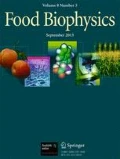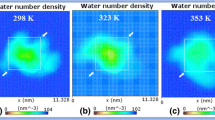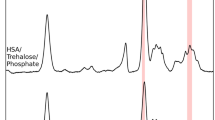Abstract
The critical aggregation concentration (CAC) for fibril formation of β-lactoglobulin (β-lg) at pH 2 was determined at 343, 353, 358, 363, and 383 K using a Thioflavin T assay and was approximately 0.16 wt%. The accuracy of the CAC was increased by measuring the conversion into fibrils at different stirring speeds. The corresponding binding energy per mol, as determined from the CAC, was 13 RT (∼40 kJ mol−1) for the measured temperature range. The fact that the CAC was independent of temperature within the experimental error indicates that the fibril formation of β-lg at pH 2 and the measured temperature range is an entropy-driven process.
Similar content being viewed by others
Introduction
Amyloid fibrils are linear protein aggregates that are typically micrometers long but only a few nanometers thick. They can be formed from various food proteins like egg white proteins1–5, soy proteins6, and whey proteins7–25. The fibrils can, for example, be used as structurants and thickeners to give food products a specific texture. However, fibrillar protein aggregation is not only studied because of its potential use in food products, but the formation of fibrils is also related with amyloid diseases, where the amyloid fibrils occur in proteinaceous deposits called plaques26. Although the amyloid fibrils have been studied in different research areas, there is a common interest in knowledge about the formation and molecular structure of the fibrils. The formation of amyloid fibrils is suggested to be a generic form of aggregation26, 27. The amyloid fibrils are characterized by a cross-β structure28, 29, where the β-sheets are arranged parallel to the long axis of the fibril, with their constituent β-strands perpendicular to this axis30, 31. Another property of the amyloid fibrils is that they have the ability to bind to amyloid specific dyes like Congo Red32 and Thioflavin T (ThT)33.
We are interested in the formation of fibrils of β-lactoglobulin (β-lg), a globular protein that has a molar mass of 18,400 g mol−1 and a radius of about 2 nm11. β-lg has been extensively studied because it is readily available in large quantities and because of its importance to the food industry34. Fibrils are formed when β-lg is heated at low pH, far from the isoelectric point of the protein11, 14, 20, 24, 34, 35. Despite extensive studies on fibril formation and the fact that it is known how to produce the β-lg fibrils, the fibril formation process is still not completely understood. For instance, the critical aggregation concentration (CAC), which is an important parameter that can be used to estimate binding energies involved in the fibril formation, is still under discussion. Having reliable values for the CAC will lead to a better understanding of the fibril formation process. Values for the CAC of fibril formation of β-lg at pH 2 that are reported in literature show a large disparity. Arnaudov et al.21 defined the critical concentration as the concentration where the conversion of protein into fibrils was too low to be determined with nuclear magnetic resonance spectroscopy; in this case, 2.5 wt% was reported. However, in their atomic force microscopy pictures, fibrils were observed in solutions with protein concentrations of 1 wt% β-lg21. Rogers et al.23 found fibril formation in equivalent β-lg solutions with concentrations as low as 0.5 wt%. In whey protein isolate (WPI) solutions, where 65% of the protein is β-lg, fibrils were formed at concentrations of 0.5 wt% WPI24. This corresponds to a β-lg concentration of about 0.33 wt%. In short, in literature, the values for the CAC of fibril formation of β-lg at pH 2 range from protein concentrations as low as 0.33 wt% up to concentrations of 2.5 wt%.
In the present study, an alternative route is used to determine the CAC for fibril formation of β-lg at pH 2 and elevated temperatures, i.e., by using the assumption that flow will influence the kinetics of fibril formation but not the thermodynamics. To obtain CAC values for the fibril formation, the conversion of protein into fibrils as a function of total protein concentration (0.2–2 wt%) was measured. This was done using a ThT assay, which is widely used to determine the presence of amyloid fibrils and to examine the kinetics of fibril formation33, 34, 36–39. To increase the accuracy of the determination of the CAC, fibrils were produced under different stirring conditions (at rest, stirred at 290 rpm, and at 1,200 rpm). The fibril formation starts with reversible aggregation, and upon longer heating, the binding between the building blocks of the fibrils becomes irreversible21, 25. Therefore, the CAC at the start of the aggregation process is treated as a thermodynamic equilibrium, and the thermodynamic principles of self-assembly40 were used to estimate the corresponding binding energy. The temperature dependence of the CAC was used to estimate the enthalpy and entropy contribution to the fibril formation.
Materials and Methods
Sample Preparation
β-lg was obtained from Sigma (product no. L0130, lot. no. 095K7006). A stock solution (about 9 wt%) was made by dissolving the protein powder in HCl solution of pH 2. The pH of the protein solution was adjusted to pH 2 with 6 M HCl solution. Subsequently, this stock solution was filtered through a protein filter (FD 30/0.45 μm Ca-S from Schleicher & Schuell) to remove any traces of undissolved protein. The protein concentration of the stock solution was determined using a UV spectrophotometer (Cary 50 Bio, Varian) and a calibration curve of known β-lg concentrations at a wavelength of 278 nm. The stock solution was diluted to protein concentrations of 2, 1, 0.5, and 0.2 wt% with HCl solution of pH 2.
Heating and Stirring
β-lg solutions of the various protein concentrations were heated in small glass vials (20 ml) in a metal stirring and heating plate for 24 h at 343, 353, 358, 363, and 383 K. The protein solutions were stirred during heating at two different stirring rates, corresponding to 290 and 1,200 rpm. At 353 K, a series of protein solutions was also heated at rest. All samples were heated in duplicates. The samples at 383 K were heated in glass vials (10 ml) with a crimp cap (with septum of silicone/polytetrafluoroethylene 3 mm) to allow pressures above atmospheric pressure.
Thioflavin T Fluorescence
The ThT fluorescence assay was used to measure the conversion of protein into fibrils after heating the protein solutions. A ThT stock solution (3.0 mM) was made by dissolving 7.9 mg ThT in 8 ml phosphate buffer (10 mM phosphate, 150 mM NaCl at pH 7.0). This stock solution was filtered through a 0.2-μm filter (Schleicher & Schuell). The stock solution was diluted 50 times in a phosphate buffer (10 mM phosphate, 150 mM NaCl at pH 7.0) before use.
After heating the protein solutions, aliquots of the fibril samples (48 μl) were mixed with 4 ml ThT solution and allowed to bind to the ThT for 1 min. The fluorescence of the samples was measured using a fluorescence spectrophotometer (Perkin Elmer LS 50 B). The excitation wavelength was set on 460 nm (slit width 4.0 nm), and the emission spectrum was recorded between 470 and 500 nm (slit width 2.5 nm) at a scanning speed of 200 nm/min. The fluorescence intensity was determined at 482 nm. The fluorescence intensity of the ThT solution was subtracted as a background. The errors in fluorescence were typically <3%.
Results and Discussion
CAC and Stirring
The fibril formation of β-lg at pH 2 was strongly dependent on the heating temperature, as can be seen in Figure 1. The optimal temperature for this fibril formation process, i.e., the temperature where the conversion was maximal, was close to 353 K. A similar optimum was found for 0.5 wt% β-lg under stirred conditions by Rogers et al.41.
To determine the CAC for fibril formation at 353 K, the conversion of protein into fibrils was measured as a function of the total protein concentration using a ThT assay. From this, the CAC was determined by extrapolating the conversion data to zero conversion. Figure 2 shows that the conversion of protein into fibrils is linearly related to the total protein concentration, with a slope depending on the stirring rate. The influence of flow on the conversion was also reported by other researchers25, 42, 43. Figure 2 shows that the three lines have a common intersection point at 0.16 wt%, showing that the CAC for fibril formation is not dependent on the stirring rate. Reversely, the CAC can be determined accurately if one uses different flow conditions. Indeed, the kinetics is changed by the flow (i.e., slope of the lines in Figure 2); the thermodynamics (intersection point of the lines in Figure 2) is not.
Binding Energy
The thermodynamics of self-assembly was used to estimate the binding energy, i.e., the decrease in the Gibbs free energy when a fibril is extended by 1 mol of building blocks40. For determining the CAC, we do not have to use thermodynamic equilibrium properties. However, at the concentration just below the CAC, thermodynamic equilibrium exists, and the principles of self-assembly are still valid. The relation between the molar fraction of fibrillar (i.e., linear) aggregates consisting of N building blocks, x N , and the binding energy, α, is given by40
with α expressed in units of RT and where x 1 is the molar fraction of the building blocks. From Eq. 1, it follows that for large N and for x 1 becoming larger than \(e^{ - \alpha } \), the right-hand term becomes much larger than unity, invalidating the requirement that x N should be smaller than 1. This implies that \(x_{{\text{1,CAC}}} \approx e^{ - \alpha } \) is a natural limit of the molar fraction of building blocks and denotes the CAC. Above this concentration, aggregates will be formed. The relation between the CAC and α can thus be written as
.
At the optimal temperature for fibril formation (353 K), the CAC, as determined from Figure 1 at a protein concentration of 0.16 wt% \(\left( {x_{1,{\text{CAC}}} = 1.6 \times 10^{ - 6} } \right)\), leads to a binding energy of 13.4 RT (39.1 kJ mol−1). Since the fibril formation of β-lg is a complex process where several mechanisms are involved, one should keep in mind that the determined binding energy is the binding energy when the fibrils are extended by 1 mol of building blocks. After this initial binding, subsequently intermolecular β-sheet formation will take place14, 15, which will make the binding stronger and irreversible, unless a strong chaotropic agent like guanidinium chloride is added21, 25, 44.
Temperature Dependence of the CAC
To see the effect of temperature on the CAC and binding energy of the fibril formation, the same experiments were also performed at 343, 358, 363, and 383 K. For these temperatures, the maximal conversion of protein into fibrils as a function of the total protein concentration are shown in Figure 3a–d. In order to measure the CAC, we need to determine the protein concentration were the fluorescence signal becomes zero (the CAC). This was done by extrapolating the conversion data to zero conversion. A priori the functional form of the conversion relative to protein concentration is unknown. However, based on the results at 353 K, we have assumed a linear relation between the total protein concentration and the conversion of protein into fibrils at all temperatures. All linear fits gave a R 2 > 0.94. The CACs and corresponding binding energies for all temperatures are shown in Table 1. All the calculated binding energies in Table 1 have a value of about 13 RT (about 40 kJ mol−1), where the binding energy has a shallow maximum at the temperature where the fibril formation is maximal, 353 K.
Enthalpy and Entropy
Using de Van ‘t Hoff equation and the temperature dependence of the CAC, the entropy and enthalpy of aggregate formation can be determined (see for example, Yu et al.45). For this, the following equations were used:
where ΔG 0 and ΔH 0 are standard molar Gibbs free energy and molar enthalpy of aggregate formation and x 1,CAC is the molar fraction of the CAC. With ΔG 0 and ΔH 0, the molar entropy of aggregate formation, ΔS 0 can be obtained. However, the values for the x 1,CAC of fibril formation of β-lg at pH 2 do not depend on the temperature (see Table 1) within the experimental error. This means that ΔH 0 is close to zero, and as a result, we find that \(\Delta S^0 \cong - \frac{{\Delta G^0 }}{T}\). Since ΔG 0 is in the order of −40 kJ mol−1 (see Table 1) the change in entropy is positive, making the fibril formation an entropy-driven process.
Conclusion
The relations between the protein concentration and the conversion into fibrils were extrapolated to obtain the CAC for fibril formation of β-lg at pH 2 and elevated temperatures. The fibril formation took place under different stirring speeds, and although the kinetics of the fibril formation was influenced by the stirring speed, the CAC was not. This was used to increase the accuracy at which the CAC was determined. The corresponding binding energy was 13 RT (∼40 kJ mol−1) for all measured temperatures. This temperature independence indicates that the growth of fibrils obtained from β-lg is an entropy-driven process.
References
M.R.H. Krebs, D.K. Wilkins, E.W. Chung et al., J. Mol. Biol. 300(3), 541 (2000). doi:10.1006/jmbi.2000.3862
C. Veerman, G. de Schiffart, L.M.C. Sagis, E. van der Linden, Int. J. Biol. Macromol. 33(1–3), 121–127 (2003). doi:10.1016/S0141-8130(03)00076-X
L.N. Arnaudov, R. de Vries, Biophys. J. 88(1), 515–526 (2005). doi:10.1529/biophysj.104.048819
M. Weijers, L.M.C. Sagis, C. Veerman, B. Sperber, E. van der Linden, Food Hydrocoll. 16(3), 269–276 (2002). doi:10.1016/S0268-005X(01)00097-2
C. Veerman, L.M.C. Sagis, J. Heck, E. van der Linden, Int. J. Biol. Macromol. 31, 139 (2003). doi:10.1016/S0141-8130(02)00074-0
C. Akkermans, A.J. van der Goot, P. Venema et al., J. Agric. Food Chem. 55(24), 9877–9882 (2007). doi:10.1021/jf0718897
M. Langton, A.-M. Hermansson, Food Hydrocoll. 5, 523–539 (1992)
J.C. Gimel, D. Durand, T. Nicolai, Macromolecules. 27(2), 583 (1994). doi:10.1021/ma00080a037
P. Aymard, D. Durand, T. Nicolai, Int. J. Pol. Anal. Char. 2(2), 115–119 (1996). doi:10.1080/10236669608233901
D. Renard, J. Lefebvre, M.C.A. Griffin, W.G. Griffin, Int. J. Biol. Macromol. 22(1), 41–49 (1998). doi:10.1016/S0141-8130(97)00086-X
P. Aymard, T. Nicolai, D. Durand, Macromolecules. 32, 2542–2552 (1999). doi:10.1021/ma981689j
C. Le Bon, T. Nicolai, D. Durand, Int. J. Food Sci. Technol. 34(5–6), 451 (1999). doi:10.1046/j.1365-2621.1999.00310.x
W.S. Gosal, S.B. Ross-Murphy, Curr Opin Colloid Interface Sci. 5(3–4), 188 (2000). doi:10.1016/S1359-0294(00)00057-1
G.M. Kavanagh, A.H. Clark, S.B. Ross-Murphy, Int. J. Biol. Macromol. 28, 41–50 (2000). doi:10.1016/S0141-8130(00)00144-6
T. Lefèvre, M. Subirade, Biopolymers. 54(7), 578–586 (2000). doi:10.1002/1097-0282(200012)54:7<578::AID-BIP100>3.0.CO;2-2
E.P. Schokker, H. Singh, D.N. Pinder, L.K. Creamer, Int. Dairy J. 10(4), 233 (2000). doi:10.1016/S0958-6946(00)00047-9
D. Durand, J.C. Gimel, T. Nicolai, Physica A 304(1–2), 253–265 (2002). doi:10.1016/S0378-4371(01)00514-3
S. Ikeda, V.J. Morris, Biomacromolecules. 3(2), 382–389 (2002). doi:10.1021/bm0156429
W.S. Gosal, A.H. Clark, P.D.A. Pudney, S.B. Ross-Murphy, Langmuir 18, 7174–7181 (2002). doi:10.1021/la025531a
C. Veerman, H. Ruis, L.M.C. Sagis, E. van der Linden, Biomacromolecules 3(4), 869 (2002). doi:10.1021/bm025533+
L.N. Arnoudov, R. de Vries, H. Ippel, C.P.M. van Mierlo, Biomacromolecules. 4, 1614–1622 (2003). doi:10.1021/bm034096b
C. Veerman, L.M.C. Sagis, E. van der Linden, Macromol. Biosci. 3(5), 243 (2003). doi:10.1002/mabi.200390035
S.S. Rogers, P. Venema, L.M.C. Sagis, E. van der Linden, A.M. Donald, Macromolecules 38, 2948–2958 (2005). doi:10.1021/ma0474224
S.G. Bolder, H. Hendrickx, L.M.C. Sagis, E. van der Linden, J. Agric. Food Chem. 54(12), 4229–4234 (2006). doi:10.1021/jf060606s
C. Akkermans, P. Venema, S.S. Rogers, A.J. van der Goot, R.M. Boom, E. van der Linden, Food Biophys. 1, 144–150 (2006). doi:10.1007/s11483-006-9012-5
F. Chiti, C.M. Dobson, Annu. Rev. Biochem. 75, 333–366 (2006). doi:10.1146/annurev.biochem.75.101304.123901
C.M. Dobson, Nature. 426(6968), 884 (2003). doi:10.1038/nature02261
G.G. Glenner, N. Engl. J. Med. 302, 1383–1292 (1980)
G.G. Glenner, N. Engl. J. Med. 302, 1333–1343 (1980)
L.C. Serpell, M. Sunde, C.C.F. Blake, Cell. Mol. Life Sci. 53, 871–887 (1997). doi:10.1007/s000180050107
R. Nelson, M.R. Sawaya, M. Balbirnie et al., Nature. 435, 773–778 (2005). doi:10.1038/nature03680
G.G. Glenner, D.L. Page, E.D. Eanes, J. Histochem. Cytochem. 20(10), 821–826 (1972)
H.H. Naiki, Anal. Biochem. 177(2), 244 (1989). doi:10.1016/0003-2697(89)90046-8
E.H.C. Bromley, M.R.H. Krebs, A.M. Donald, Faraday Discuss. 128, 13–27 (2005). doi:10.1039/b403014a
W.S. Gosal, A.H. Clark, S.B. Ross-Murphy, Biomacromolecules. 5(6), 2408–2419 (2004). doi:10.1021/bm049659d
H. LeVine, Methods Enzymol. 309, 285–305 (1999). doi:10.1016/S0076-6879(99)09021-7
H. Naiki, F. Gejyo, Methods Enzymol. 309, 305–318 (1999). doi:10.1016/S0076-6879(99)09022-9
L. Nielsen, R. Khurana, A. Coats et al., Biochemistry. 40(20), 6036–6046 (2001). doi:10.1021/bi002555c
M. Groenning, L. Olsen, M. van de Weert, J.M. Flink, S. Frokjaer, F.S. Jørgensen, J. Struct. Biol. 158, 358–369 (2007). doi:10.1016/j.jsb.2006.12.010
J. Israelachvili, Intermolecular & Surface Forces (Academic, California, USA, 1992), pp. 341–365
S.S. Rogers, Some physical properties of amyloid fibrils, PhD Thesis, Cambridge University, UK, 2005.
E.K. Hill, B. Krebs, D.G. Goodall, G.J. Howlett, D.E. Dunstan, Biomacromolecules. 7(1), 10–13 (2006). doi:10.1021/bm0505078
S.G. Bolder, L.M.C. Sagis, P. Venema, E. van der Linden, J. Agric. Food Chem. 55(14), 5661–5669 (2007). doi:10.1021/jf063351r
F. Meersman, C.M. Dobson, Biochim. Biophys. Acta (BBA)—Proteins & Proteomics 1764(3), 452–460 (2006)
J.-A. Yu, S.-H. Oh, Y-R. Park, J.-S. Kim, Macromol. Symp. 249–250, 445–449 (2007). doi:10.1002/masy.200750417
Acknowledgments
The authors acknowledge the Dutch research school VLAG and the Dutch research program MicroNed for the financial support of this project.
Open Access
This article is distributed under the terms of the Creative Commons Attribution Noncommercial License which permits any noncommercial use, distribution, and reproduction in any medium, provided the original author(s) and source are credited.
Author information
Authors and Affiliations
Corresponding author
Rights and permissions
Open Access This is an open access article distributed under the terms of the Creative Commons Attribution Noncommercial License (https://creativecommons.org/licenses/by-nc/2.0), which permits any noncommercial use, distribution, and reproduction in any medium, provided the original author(s) and source are credited.
About this article
Cite this article
Kroes-Nijboer, A., Venema, P., Bouman, J. et al. The Critical Aggregation Concentration of β-Lactoglobulin-Based Fibril Formation. Food Biophysics 4, 59–63 (2009). https://doi.org/10.1007/s11483-009-9101-3
Received:
Accepted:
Published:
Issue Date:
DOI: https://doi.org/10.1007/s11483-009-9101-3







